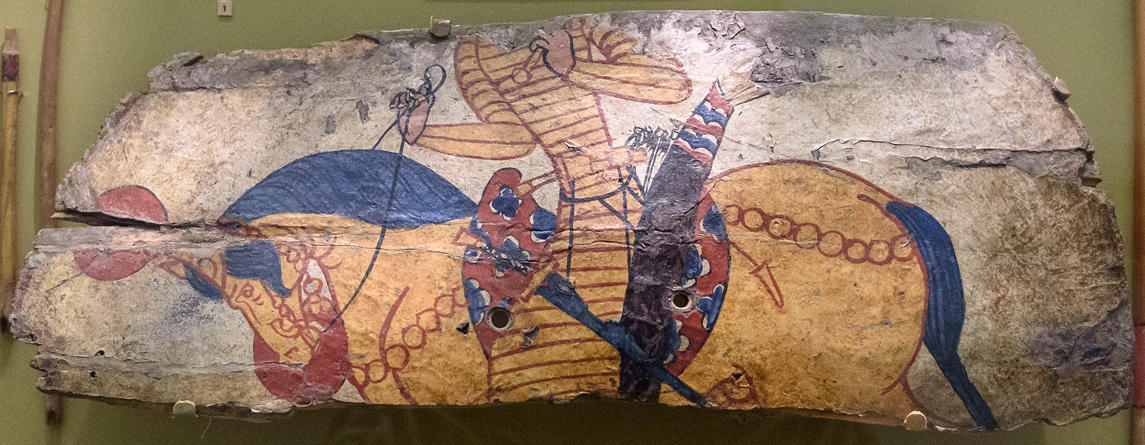Try Amazon Audible Plus

Create an Amazon Business Account
Painted Soghdian Horseman on a Shield from Mount Mugh
Hermitage Museum, St Petersburg

A larger image of this Painted Soghdian Horseman on a Shield from Mug.
Photo by Oleg Belaychuk
Referenced as illustration 78, p.96 in Tamara Talbot Rice, Ancient Arts of Central Asia, 1965
78 Though only the central portion of this painted shield survives, it suffices to show that the broad-shouldered,
wasp-waisted hero of Islamic Persia was already admired in the eighth century. It was found at Mug castle
p. 96
... Numerous coins, seals, articles in silver and bronze, weapons and fragments of silk and cotton stuffs were recovered from the site but,
apart from the manuscripts, the importance of which can hardly be equalled, the most interesting find consisted of a wooden shield (Ill. 78)
covered with fine leather decorated with a painting of a rider.
Though only the central panel survives, with the result that the rider's head and feet are missing, the painting is in good condition.
Enough remains to show that it was executed in the same style as the mural-paintings which have been discovered more recently in various parts of Soghdia.
All clearly belong to the same flourishing, distinctive and accomplished school as the lost fragments from Afrasiab,
and the group as a whole provides enough evidence to justify the suggestion that it was works such as these
that played an all-important part in fashioning the style of Persia's school of Islamic painting.
78 Shield (fragment): horseman. Wood covered with leather. Mug Castle. Soghdian, eighth century.
Referenced as figure 443 in The military technology of classical Islam by D Nicolle
443. Fragment of a painted shield from the Castle of Mug, early 8th century AD, west Turkistānī, Hermitage, Leningrad (Rob OAS Ric A).
Vol. 2, p315. The fact that lamellar sleeves do not appear at Piandjikent may not mean that they never existed beneath those short-sleeved boleros.
They are clearly shown on another equally famous source from the area of Ushrusana, the leather-covered early 8th century shield from the castle of Mug (Fig. 443).
In almost all other respects the horseman shown on this shield is identical to those slightly earlier warriors of Piandjikent.
Note that on this somewhat crude picture, the vertical lines between individual lamellae are not drawn, whereas the horizontal lines indicating rows of lamellae are so drawn.
Short-sleeved lamellar cuirasses such as this are more common in the art of eastern Turkistān (Figs. 454 and 462), though the earliest representations come from an area nearer to China than to Iran.
454. Fresco in City Cave, 8th century AD, east Turkistānī, in situ, Sorcuk (Stein S).
462. Painted silk and paper fragments from a Manichaean temple, Kačo, 8th-9th centuries AD, east Turkistānī, Museum für Völk., Staatliche Murseen Dahlem, West Berlin (Coq).
Referenced on p.16, EH - 071 - The Great Islamic Conquests AD 632-750 by David Nicolle
One of the best illustrations of a fully armoured cavalryman from the early Islamic period was painted on a shield.
It was found in the castle of Mug and dates from the early 8th century when this part of Central Asia was an autonomous frontier province of the Umayyad Caliphate.
(State Hermitage Museum, St Petersburg, Russia)
Referenced on p.14, The Armies of Islam 7th-11th Centuries by David Nicolle & Angus McBride
Upper part of a round, leather-covered wooden shield from western Turkestan; it has two holes of the original four for small bosses,
and is decorated with a mounted warrior wearing lamellar armour.
The shield was found in the castle of Mug, which was sacked after rebelling against Muslim rule in the 8th century. (Hermitage, Leningrad)
... fragments of a shield made of wooden planks and covered with parchment. On its outer side there is a painted figure of a Sogdian armored mounted warrior, and on the other side is a painted imitation of a leopard skin.
MUGH, MOUNT, iranicaonline
See also Sogdian split tapestry (kilim) coat with animal motifs, Central Asia, 9th/10th
Other 8th Century Illustrations of Costume & Soldiers


